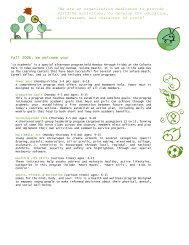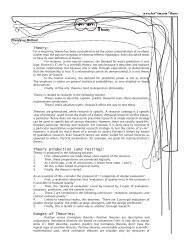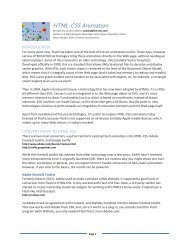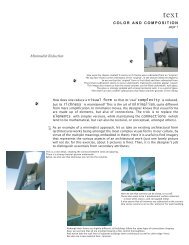ULTRAPERFORMING Beams/ Columns Doors ... - fen-om data
ULTRAPERFORMING Beams/ Columns Doors ... - fen-om data
ULTRAPERFORMING Beams/ Columns Doors ... - fen-om data
You also want an ePaper? Increase the reach of your titles
YUMPU automatically turns print PDFs into web optimized ePapers that Google loves.
LightPoints glass is available in rectangular formats up to a maximum of 1,300 mm (51“) x 2,500<br />
mm (98“), and larger rectangular formats and free forms are available on request. Standard glass<br />
thickness is: 2 x 4 mm or 2 x 6 mm (.079“ x .157“ or .079“ x .236“). Schott is developing the<br />
LightPoints range for skylight windows, walkable glass and accessories for h<strong>om</strong>e use.<br />
www.us.schott.c<strong>om</strong>/architecture/english/lightsolutions<br />
Metallic Laminated Glass<br />
A remarkably tough protective interlayer, also known as polyvinyl butyral or PVB, is the<br />
highperformance c<strong>om</strong>ponent in laminated glass. Laminated architectural glass is produced by<br />
bonding the PVB based interlayer between two or more panes of glass under heat and pressure.<br />
The result is durable, adaptable, high-performance glazing which, if broken, tends to retain glass<br />
fragments and reduces the risk of injury or property damage. While exploring the possibilities of<br />
creating a metallic interlayer for glass, Solutia’s technology team discovered a way to add texture<br />
to the glass at the same time. The effect is glass that appears to have a rich, almost fabric-like<br />
appearance, while incorporating subtle shimmering elements. To add color, this special metallic<br />
interlayer can be c<strong>om</strong>bined with Solutia’s range of ten foundational Vanceva Design color hues to<br />
achieve jewel-like brilliant color or softer shades. For a more cust<strong>om</strong> look, various palette colors<br />
can be c<strong>om</strong>bined to create up to 62 different colors.<br />
www.vanceva.c<strong>om</strong><br />
Structural Channel Glass<br />
Pilkington Profilit is a translucent cast glass structural glazing system which consists of a series<br />
of self-supporting glass channels within an extruded metal perimeter frame. The system is<br />
relatively cost-effective, and well-suited for exterior and interior curved wall applications. The<br />
long, sweeping wall of Steven Holl’s<br />
Museum of Contemporary Art in Helsinki, for instance, is c<strong>om</strong>prised of Pilkington Profilit. The<br />
U-shaped glass channels are formed by c<strong>om</strong>puter-controlled furnaces, and are inherently<br />
strong enough to be installed without additional vertical or horizontal supports. A high-quality<br />
translucent silicone sealant which matches the natural tint of the glass must be used at all joints<br />
to make the system weathertight.<br />
www.reglit.c<strong>om</strong><br />
Translucent Insulated Glazing Unit<br />
Solera is a glass-based insulated translucent glazing unit manufactured using a proprietary<br />
honeyc<strong>om</strong>b transparent insulation material. This semi-rigid insulating core is mounted between<br />
two layers of glass, similar to the way that conventional insulations such as rigid foam or glass<br />
fiber fill the gap inside a wall. Solera provides insulation value by suppressing convection and<br />
thermal radiation in the space between the glass layers. At the same time, the honeyc<strong>om</strong>b<br />
structure of the core ensures that light striking the cell walls is reflected forward through the<br />
material to the interior of the building. A choice of translucent veil material used in conjunction<br />
with the insulation core provides the opportunity to “dial in” light transmittance values fr<strong>om</strong> 22%<br />
to 73%. Solera delivers both maximum insulation value as well as high light transmittance, which<br />
cannot be achieved by using conventional fiber-reinforced plastic construction.<br />
www.advancedglazings.c<strong>om</strong><br />
Lighting<br />
Conductive Plastic<br />
You might mistake Alan Heeger for a slimmeddown Jerry Garcia clone - white mane and beard,<br />
laid-back attitude, all-black outfit. Ask the UC Santa Barbara physicist to empty his pockets and<br />
you won’t find guitar picks and a roach clip. But he will produce a handful of transparent vials.<br />
Inside each is an ounce of clear liquid infused with invisible flecks of plastic that mimic the<br />
molecular structure and behavior of metal. Zap the solution with electricity -or simply expose it<br />
to a bright light –and the mixture emits a steady glow. Neat trick. Heeger and two colleagues won<br />
the 2000 Nobel Prize in chemistry for the acc<strong>om</strong>plishment: coaxing conductivity fr<strong>om</strong> plastic.<br />
(The material in the vials is a luminescent semiconducting polymer.) Now their efforts, and those<br />
of a growing number of chemists, physicists, and engineers, are clearing the way for superthin<br />
digital screens, polymer c<strong>om</strong>puter memory, disposable electronics, and a new generation of<br />
smartcards. Conventional plastic is a lousy conductor. Viewed using an electron microscope, its<br />
molecular structure resembles a snarl of spaghetti. But arranging polymer molecules into long,<br />
straight rods lets electrons flow freely, approximating the conductivity of traditional materials<br />
like silicon or copper. Heeger and his co-Nobelists, for example, discovered that oxidizing the<br />
polymer polyacetylene with iodine vapors increased conductivity more than a billionfold.








